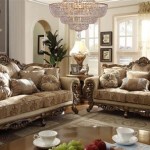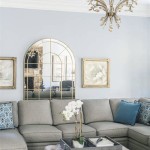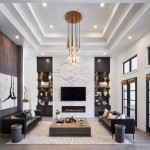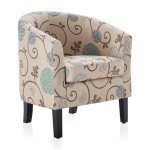Two-Toned Furniture: A Striking Design Element for Living Rooms
Two-toned furniture, characterized by the use of contrasting colors or materials in a single piece, represents a versatile and visually engaging design approach applicable to various living room styles. It offers a departure from monolithic color schemes, introducing depth, texture, and a personalized aesthetic to the space. The deliberate juxtaposition of different finishes can highlight specific design features, create focal points, and contribute to a more dynamic and interesting interior.
The appeal of two-toned furniture lies in its adaptability. It can be implemented in subtle, understated ways, such as using a light wood frame with darker upholstery, or in more dramatic expressions with bold color combinations and contrasting textures. The key to successful implementation lies in understanding the principles of color theory, considering the existing architectural elements of the room, and selecting pieces that complement the overall design vision.
Two-toned furniture encompasses a wide range of pieces, from sofas and chairs to coffee tables, sideboards, and entertainment units. The choice of furniture type will depend on the desired impact and the specific needs of the living room. A statement two-toned sofa, for instance, can become the centerpiece of the room, while a two-toned coffee table can add a subtle touch of visual interest without overwhelming the space.
Highlighting Architectural Features with Two-Toned Furniture
One of the significant benefits of incorporating two-toned furniture is its capacity to accentuate or complement existing architectural features. In living rooms with prominent molding, wainscoting, or built-in shelving, carefully selected two-toned pieces can reinforce the design language of these elements. For example, a sideboard with a dark base and a lighter cabinet top can mirror the color scheme of the wainscoting, creating a cohesive and harmonious look.
In rooms with neutral walls, two-toned furniture can serve as a primary source of visual interest. By choosing pieces with contrasting colors, the furniture can act as an anchor, drawing the eye and defining the space. Conversely, in rooms with bold or patterned wallpaper, two-toned furniture with more muted and complementary colors can provide a calming counterpoint, preventing the room from feeling overwhelming.
The selection of colors for two-toned furniture should be carefully considered in relation to the existing light conditions of the room. In naturally bright spaces, darker colors can be used more liberally without making the room feel small or cramped. In dimly lit rooms, lighter colors and reflective materials can help to maximize the available light and create a more open and airy feel.
The placement of two-toned furniture is also crucial for its effective integration into the living room. It is generally advisable to position the furniture in a way that allows its contrasting elements to be easily visible and appreciated. For example, a two-toned sofa should be placed in a location where its different colors are not obscured by other furniture or accessories. Consider the viewing angles from the entrance to the room and other key vantage points to ensure the desired impact is achieved.
Creating Focal Points and Defining Zones
Two-toned furniture can be strategically used to create focal points within the living room. A brightly colored or unusually designed two-toned chair, for example, can instantly draw attention and serve as a conversation starter. Similarly, a two-toned entertainment unit can be used to anchor the television area and provide a visual counterpoint to the surrounding walls.
In open-plan living spaces, two-toned furniture can be employed to define different zones. By using different colors and materials for furniture in different areas of the room, it is possible to create a sense of separation and delineation without resorting to physical barriers. For example, a living room area might feature a sofa with a light-colored upholstery and dark wood frame, while a dining area might feature chairs with dark upholstery and light wood frames.
The choice of colors for zoning purposes should be guided by the intended use of each area. Calming colors such as blues and greens are often used in relaxation areas, while more stimulating colors such as reds and yellows may be used in areas designated for activity or entertainment. The consistency of the color palette across different zones is important in order to maintain a sense of cohesiveness and prevent the room from feeling disjointed.
In addition to color, the texture of the materials used in two-toned furniture can also contribute to defining zones. For example, a living room area might feature furniture with soft, plush upholstery, while a dining area might feature furniture with smooth, polished surfaces. The contrast in textures can further enhance the sense of separation between the different zones.
Exploring Different Styles with Two-Toned Furniture
The versatility of two-toned furniture extends to its applicability across a wide range of interior design styles. From modern minimalist to traditional and eclectic, two-toned furniture can be adapted to suit different aesthetic preferences.
In modern minimalist interiors, two-toned furniture can be used to add a subtle touch of visual interest without compromising the clean lines and uncluttered feel of the space. Pieces with neutral colors and simple geometric designs are often preferred. For instance, a sofa with a light gray fabric and a dark metal frame can blend seamlessly into a minimalist setting, while still adding a touch of sophistication.
In traditional interiors, two-toned furniture can be used to enhance the sense of warmth and character. Pieces with rich colors, intricate details, and classic designs are often chosen. A wooden coffee table with a contrasting inlay, or a chair with a patterned fabric and a solid wood frame, can complement the traditional aesthetic while adding a personal touch.
In eclectic interiors, two-toned furniture can be used to create a sense of whimsy and individuality. Pieces with bold colors, unusual shapes, and unexpected combinations of materials are often embraced. The key to successfully incorporating two-toned furniture into an eclectic setting is to maintain a sense of balance and harmony, ensuring that the different elements of the room work together to create a cohesive and visually appealing whole.
Ultimately, the selection and implementation of two-toned furniture in a living room depends on a careful assessment of the existing space, the desired aesthetic, and the personal preferences of the homeowner. By understanding the principles of color theory, considering the architectural features of the room, and selecting pieces that complement the overall design vision, it is possible to create a stunning and personalized living space that reflects individual style and taste.
The careful consideration of scale is also vitally important. Pieces of two-toned furniture need to be in proportion to the room and surrounding items. A large, imposing two-toned sofa will overwhelm a small living room, whereas a diminutive two-toned side table will be lost in a large space. Taking measurements and visualizing the furniture within the room before purchasing is advisable.
Consider the flow of the room. Two-toned furniture should not obstruct pathways or make it difficult to navigate the space. Placement needs to carefully considered to maximize functionality and create a welcoming and comfortable atmosphere. This often involves experimenting with different arrangements until the optimal configuration is found.
Maintenance and upkeep are also essential. Different materials used in two-toned furniture might require different cleaning and care procedures. Understanding the specific needs of each material and following the manufacturer's instructions will help to preserve the furniture's appearance and extend its lifespan. Regular cleaning and preventative maintenance will prevent damage and ensure that the furniture continues to enhance the living room for years to come.

Two Tone Sofa

Can I Have Two Different Sofas In The Living Room Answered Decor Snob

House Delphine 2 Piece Sofa Set In Two Tone Ivory Fabric Beige Pu Charcoal Finish By Acme 58830 S

Contemporary Two Tone Sofa Set Upholstered In Chocolate Microfiber Los Angeles Gf880018mf

Dreena Living Room Set In Two Tone Brown
.jpg?strip=all)
Two New Living Room Paint Colors Dream Green Diy

Two Tone Sofas Hi 5 Home Furniture

Two Tone Contemporary Living Room Sofa W Multi Color Pillows

How To Style A Dual Tone Sofa Set

House Marchese 2 Piece Sofa Set In Pearl White Pu Two Tone Beige Fabric Gold








